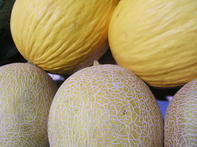
Propagation
Cantaloupe propagation is from seed.Cantaloupe Planting Method
Cantaloupe Planting is done by direct sowing or planting of the cantaloupe seed or by first making seedlings in seed beds or seed trays and planting the plants out into the production area.
Spacing
Cantaloupe Plants are spaced 50 - 75 cm apart in rows that are 100 - 200 cm apart. This is between 4000 and 6000 cantaloupe plants per hectare. Access rows for implements and tractors must be left for spraying and harvesting.
Sowing Time
Direct planting of seeds is from late August to November in South Africa. Seeds can be planted into seedling trays and planted in a greenhouse from early July to ready seedlings for planting by mid-August if the weather has started to warm by then.Planting Time
As the cantaloupe is a warm weather crop planting is from early September to mid December. In warmer areas where the spring warmer weather arrives early planting can start in mid August.Cantaloupe Growth Period
The growing period from seed to production is normally from 12 weeks in warm areas to 15 weeks in areas that the spring weather is slower to warm up.Fertilization
It is always best to do proper soil analysis to ascertain the soil’s nutrient requirements and to fertilize accordingly. A good guide to fertilizing is as follows: The compost, lime and manure are ploughed in during soil preparation four to six weeks before planting. A pre-plant application of between 750 and 1000 kg of 2:3:4 (27) fertilizer mix per hectare is spread over the plant rows and disc harrowed into the top 20 cm of soil prior to planting of seedlings.
About four to six weeks after planting apply a further 300 to 500 kg of 2:3:4 (27) per hectare to ensure good growth and set of fruit. Monitor growth and set of fruit and if deemed necessary apply a third application of 350 kg per hectare of Potassium Nitrate to aid growth and boost fruit development.
If at this stage the growth is vigorous enough apply Potassium Chloride instead of the Potassium Nitrate. At this late stage it is more important to fertilize for fruit quality rather than vegetative growth. Remember to irrigate after every fertilizer application.
Irrigation
Irrigate before and after planting for seeds or seedlings. When planting seedlings this helps to minimize the stress on new seedlings. Make sure to minimize soil moisture stress.
If it is possible install soil moisture meters and if this is not possible check the soil of the root zone at least twice per week with a soil augur or spade. A good average irrigation is between 25 and 35 mm per week. Depending on the kind of soil this can be done with 2 or 3 applications per week.